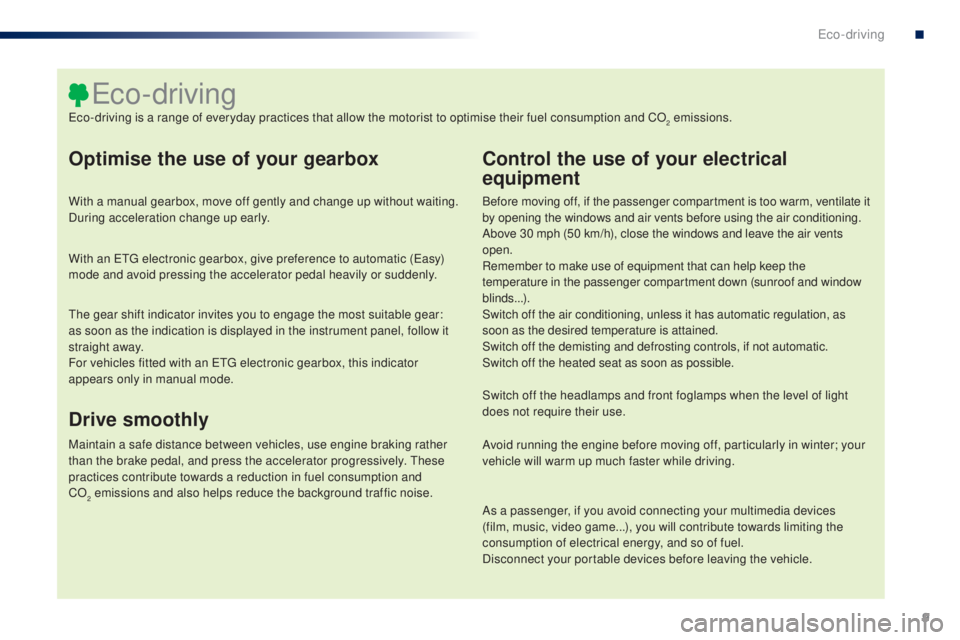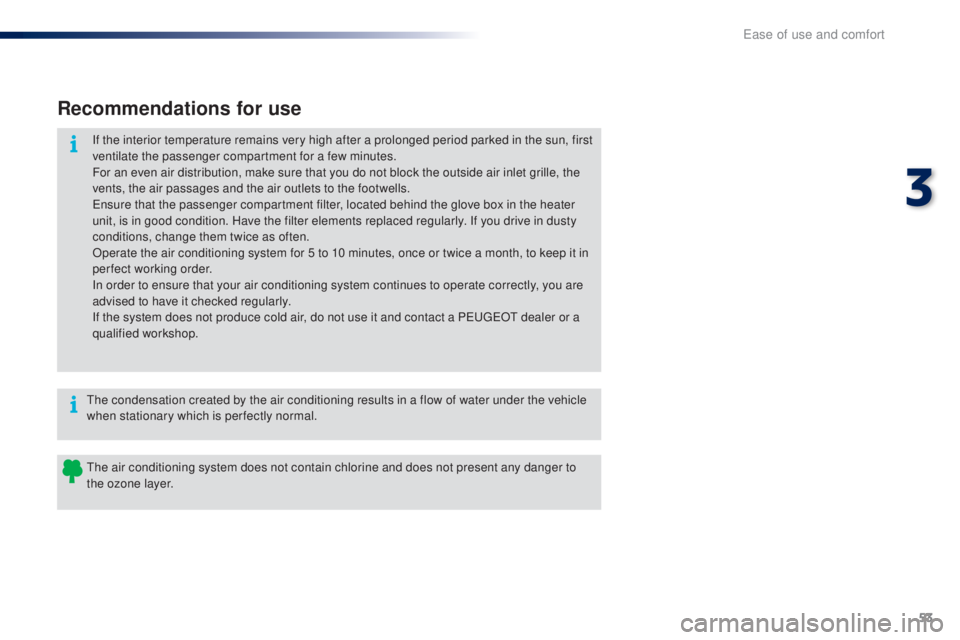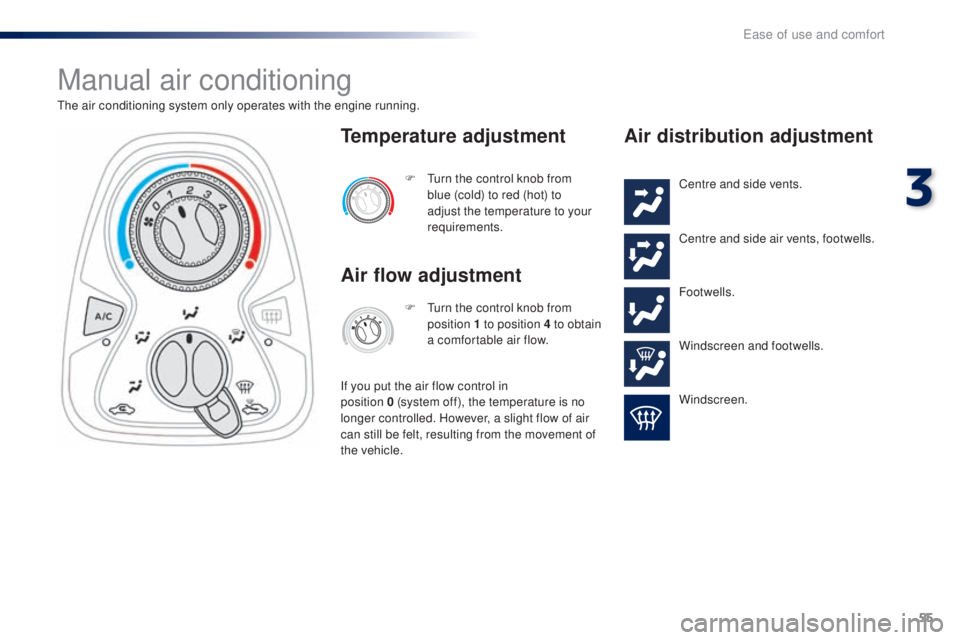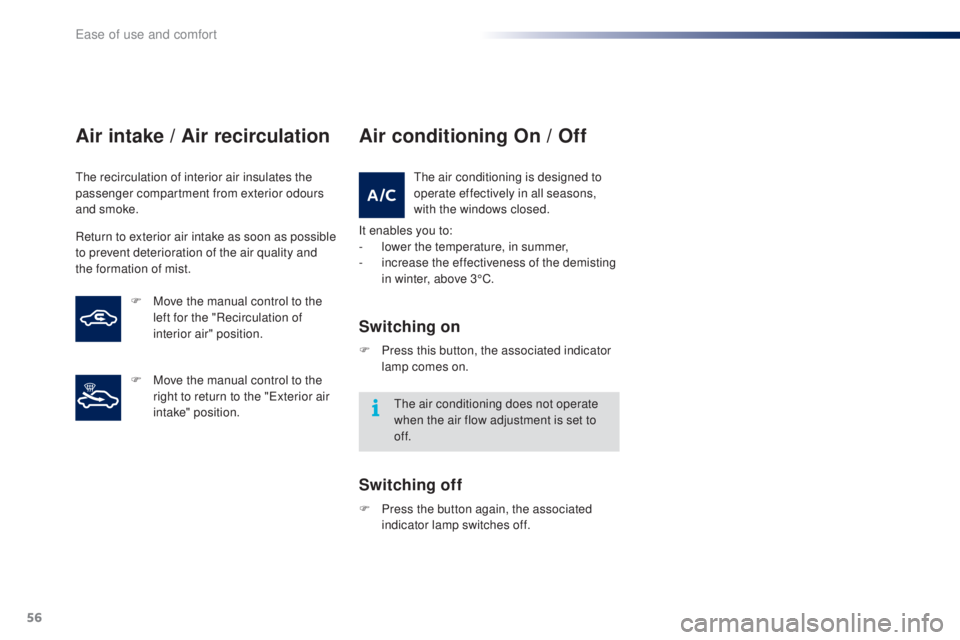2016 PEUGEOT 108 air condition
[x] Cancel search: air conditionPage 4 of 268

.
.
108_en_Chap00a_sommaire_ed01-2016
Instrument panels 11
Display screens
1
3
Indicator and warning lamps
1
5
Indicators
26
tr
ip computer
2
7
Setting the time
2
9
InstrumentsOver view
Keys
31
Keyless e
n
try and Starting system
3
4
Doors
38
Boot
39
Front electric windows
4
1
Rear quarter windows
4
1
ele
ctric fabric roof
4
2
Access
Front seats 4 6
Rear seats
4
8
Mirrors
50
Steering wheel adjustment
5
1
Ventilation
52
Heating
54
Manual air conditioning
5
5
Automatic air conditioning
5
7
Front demist - defrost
6
0
Rear screen demist - defrost
6
1
Courtesy lamp
6
2
Boot lamp
6
2
Interior fittings
6
3
Rear parcel shelf
6
7
Boot fittings
6
8
ease of use and comfort
Driving recommendations 70
Starting - switching off the engine
with the key
7
1
Starting - switching off the engine with
the
Keyless e
n
try and Starting system
7
2
Manual parking brake
7
6
5-speed manual gearbox
7
6
e
tg
el
ectronic gearbox
7
7
ge
ar shift indicator
8
1
Hill start assist
8
2
Stop & Start
8
3
Speed limiter
8
6
Reversing camera
9
2
Lane departure warning system
9
3
Under-inflation detection
9
5
Driving
e
co-driving
Contents
Page 8 of 268

6
108_en_Chap00b_vue-ensemble_ed01-2016
Dashboard fuses 168-172
Instruments and controls
Door mirrors 5 0el
ectric windows 4 1Courtesy lamp
6
2
Control for electric fabric roof
4
2
Rear view mirror
5
1
Sun visors
6
4
Manual parking brake
7
6Heating, ventilation
5
2-54
Manual air conditioning
5
5-56
Automatic air conditioning
5
7-59
Windscreen demist / defrost
6
0
Rear screen demist / defrost
61
7-inch touch screen
1
85 -234
Radio
235-254
Setting the time
2
9, 30
Manual gearbox
7
6
e
tg
el
ectronic gearbox
7
7-80
ge
ar shift indicator
8
1
Hill start assist
8
2
12 V accessory socket
6
4
uS
B port
6
5
Jack auxiliary socket
6
5
Instrument panel
1
1-12
Rev counter
1
2
Central screen
1
3
Indicator and warning lamps
1
5-25
Indicators 26
tr
ip computer
2
7-28
Side air vents
5
2
Passenger's front airbag
1
19
gl
ove box
6
4
Deactivating the passenger's front airbag
119
Reinitialising the under-inflation detection 96-97
Over view
Page 11 of 268

9
108_en_Chap00c_eco-conduite_ed01-2016
optimise the use of your gearbox
With a manual gearbox, move off gently and change up without waiting.
During acceleration change up early.
With an etg electronic gearbox, give preference to automatic (
ea
sy)
mode and avoid pressing the accelerator pedal heavily or suddenly.
Control the use of your electrical
equipment
Before moving off, if the passenger compartment is too warm, ventilate it
by opening the windows and air vents before using the air conditioning.
Above 30 mph (50 km/h), close the windows and leave the air vents
open.
Remember to make use of equipment that can help keep the
temperature in the passenger compartment down (sunroof and window
blinds...).
Switch off the air conditioning, unless it has automatic regulation, as
soon as the desired temperature is attained.
Switch off the demisting and defrosting controls, if not automatic.
Switch off the heated seat as soon as possible.
Switch off the headlamps and front foglamps when the level of light
does not require their use.
Avoid running the engine before moving off, particularly in winter; your
vehicle will warm up much faster while driving.
As a passenger, if you avoid connecting your multimedia devices
(film, music, video game...), you will contribute towards limiting the
consumption of electrical energy, and so of fuel.
Disconnect your portable devices before leaving the vehicle.
eco-driving
eco-driving is a range of everyday practices that allow the motorist to optimise their fuel consumption and CO2 emissions.
th
e gear shift indicator invites you to engage the most suitable gear:
as soon as the indication is displayed in the instrument panel, follow it
straight away.
For vehicles fitted with an
etg
electronic gearbox, this indicator
appears only in manual mode.
Drive smoothly
Maintain a safe distance between vehicles, use engine braking rather
than the brake pedal, and press the accelerator progressively. th ese
practices contribute towards a reduction in fuel consumption and
CO
2 emissions and also helps reduce the background traffic noise.
.
eco-driving
Page 24 of 268

22
Parking brakefixed, accompanied by
an audible signal.th e parking brake is applied or not
properly released. Release the parking brake to switch off the warning
lamp, keeping your foot on the brake pedal.
Observe the safety recommendations.
For more information on the parking brake, refer to the
corresponding section.
Warning / indicator lamp
StateCause Action / o
b
servations
Passenger's
front airbag fixed in the seat belt
and passenger's front
airbag warning lamps
display.
th
e control switch, located in the
glove box, has been placed in the
"
o
N
" position.
the
passenger's front airbag is activated.
In this case, do not install a rear ward facing child seat.
Stop & Star t
(V
ti 6
8 S&S
engine) fixed.
When the vehicle stops (red lights,
traffic jams...) the Stop & Start system
has put the engine into S
tO
P mode.
th
e indicator lamp goes off and the engine restarts
automatically in S
tA
R
t
mode, as soon as you want to
move off.
Keyless
e
n
tr y
and Starting
system fixed.
th
e conditions for starting are met. For more information, refer to the "Starting - switching off the engine with the Keyless
e
n
try and Starting
system" section.
flashing slowly.
th
e vehicle is in "ACC" mode.
th
e accessories (audio system,
12V socket...) can be used.
Instruments
Page 46 of 268

44
108_en_Chap02_ouvertures_ed01-2016
An aero-acoustic deflector is available to
improve the acoustic comfort of occupants
of the vehicle in certain driving conditions
(high speed), by reducing the turbulence in
the passenger compartment resulting from the
displacement of air.
On opening the roof, the aero-acoustic
deflector is deployed.
On closing the roof, the deflector folds away
automatically.
Aero-acoustic deflector Precautions for use
Never place objects on the roof,
whether open or closed.
Never sit on or place objects on the
transverse roof support when the roof
is open. In the event of prolonged storage of the
vehicle outside, it is recommended that
the roof be protected with a cover.
to a
void damaging the roof, do
not open it under snowy or frosty
conditions.
Never use sharp tools to remove ice or
accumulations of snow on the roof.
to l
imit the creation of folds in the roof
fabric, it is recommended that the roof
not be left open for long periods.
th
e vehicle's air conditioning system
should not be operated while the roof
is open. It is recommended that the roof be
closed when the vehicle is left parked.
ev
en if the roof is closed, it is prudent
not to leave any valuable objects inside
the vehicle.
When you leave the vehicle, switch off
the ignition and remove the key (take
the electronic key with you) to avoid any
unwanted operation of the roof.
Access
Page 55 of 268

53
108_en_Chap03_ergonomie-confort_ed01-2016
Recommendations for use
If the interior temperature remains very high after a prolonged period parked in the sun, first
ventilate the passenger compartment for a few minutes.
For an even air distribution, make sure that you do not block the outside air inlet grille, the
vents, the air passages and the air outlets to the footwells.
en
sure that the passenger compartment filter, located behind the glove box in the heater
unit, is in good condition. Have the filter elements replaced regularly. If you drive in dusty
conditions, change them twice as often.
Operate the air conditioning system for 5 to 10 minutes, once or twice a month, to keep it in
perfect working order.
In order to ensure that your air conditioning system continues to operate correctly, you are
advised to have it checked regularly.
If the system does not produce cold air, do not use it and contact a P
e
uge
Ot
dealer or a
qualified workshop.
th
e air conditioning system does not contain chlorine and does not present any danger to
the ozone layer.
th
e condensation created by the air conditioning results in a flow of water under the vehicle
when stationary which is per fectly normal.
3
ease of use and comfort
Page 57 of 268

55
108_en_Chap03_ergonomie-confort_ed01-2016
Manual air conditioning
the air conditioning system only operates with the engine running.F t
u
rn the control knob from
blue (cold) to red (hot) to
adjust the temperature to your
requirements.
temperature adjustment
Air flow adjustment
F turn the control knob from position 1 to position 4 to obtain
a comfortable air flow.
If you put the air flow control in
position
0
(system off), the temperature is no
longer controlled. However, a slight flow of air
can still be felt, resulting from the movement of
the vehicle.
Air distribution adjustment
Centre and side vents.
Centre and side air vents, footwells.
Footwells.
Windscreen and footwells.
Windscreen.
3
ease of use and comfort
Page 58 of 268

56
108_en_Chap03_ergonomie-confort_ed01-2016
Air intake / Air recirculation
the recirculation of interior air insulates the
passenger compartment from exterior odours
and smoke.
Return to exterior air intake as soon as possible
to prevent deterioration of the air quality and
the formation of mist.
Air conditioning on / of f
the air conditioning is designed to
operate effectively in all seasons,
with the windows closed.
It enables you to:
-
l
ower the temperature, in summer,
-
i
ncrease the effectiveness of the demisting
in winter, above 3°C.
Switching on
F Press this button, the associated indicator lamp comes on.
th
e air conditioning does not operate
when the air flow adjustment is set to
of f.
Switching off
F Press the button again, the associated indicator lamp switches off.
F
M
ove the manual control to the
left for the "Recirculation of
interior air" position.
F
M
ove the manual control to the
right to return to the "
ex
terior air
intake" position.
ease of use and comfort